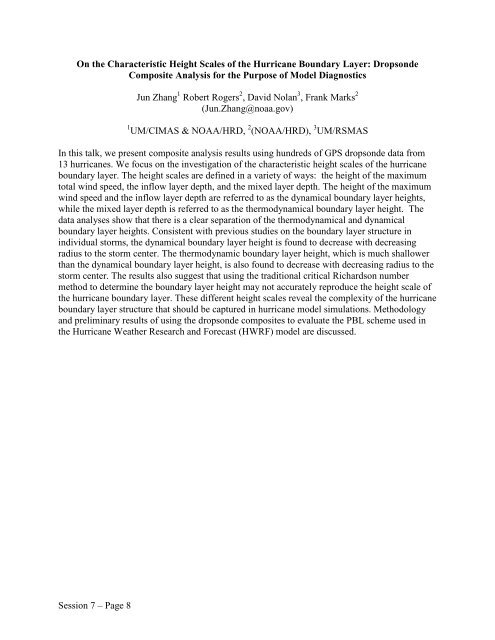65th IHC Booklet/Program (pdf - 4.9MB) - Office of the Federal ...
65th IHC Booklet/Program (pdf - 4.9MB) - Office of the Federal ...
65th IHC Booklet/Program (pdf - 4.9MB) - Office of the Federal ...
Create successful ePaper yourself
Turn your PDF publications into a flip-book with our unique Google optimized e-Paper software.
On <strong>the</strong> Characteristic Height Scales <strong>of</strong> <strong>the</strong> Hurricane Boundary Layer: Dropsonde<br />
Composite Analysis for <strong>the</strong> Purpose <strong>of</strong> Model Diagnostics<br />
Jun Zhang 1 Robert Rogers 2 , David Nolan 3 , Frank Marks 2<br />
(Jun.Zhang@noaa.gov)<br />
1 UM/CIMAS & NOAA/HRD, 2 (NOAA/HRD), 3 UM/RSMAS<br />
In this talk, we present composite analysis results using hundreds <strong>of</strong> GPS dropsonde data from<br />
13 hurricanes. We focus on <strong>the</strong> investigation <strong>of</strong> <strong>the</strong> characteristic height scales <strong>of</strong> <strong>the</strong> hurricane<br />
boundary layer. The height scales are defined in a variety <strong>of</strong> ways: <strong>the</strong> height <strong>of</strong> <strong>the</strong> maximum<br />
total wind speed, <strong>the</strong> inflow layer depth, and <strong>the</strong> mixed layer depth. The height <strong>of</strong> <strong>the</strong> maximum<br />
wind speed and <strong>the</strong> inflow layer depth are referred to as <strong>the</strong> dynamical boundary layer heights,<br />
while <strong>the</strong> mixed layer depth is referred to as <strong>the</strong> <strong>the</strong>rmodynamical boundary layer height. The<br />
data analyses show that <strong>the</strong>re is a clear separation <strong>of</strong> <strong>the</strong> <strong>the</strong>rmodynamical and dynamical<br />
boundary layer heights. Consistent with previous studies on <strong>the</strong> boundary layer structure in<br />
individual storms, <strong>the</strong> dynamical boundary layer height is found to decrease with decreasing<br />
radius to <strong>the</strong> storm center. The <strong>the</strong>rmodynamic boundary layer height, which is much shallower<br />
than <strong>the</strong> dynamical boundary layer height, is also found to decrease with decreasing radius to <strong>the</strong><br />
storm center. The results also suggest that using <strong>the</strong> traditional critical Richardson number<br />
method to determine <strong>the</strong> boundary layer height may not accurately reproduce <strong>the</strong> height scale <strong>of</strong><br />
<strong>the</strong> hurricane boundary layer. These different height scales reveal <strong>the</strong> complexity <strong>of</strong> <strong>the</strong> hurricane<br />
boundary layer structure that should be captured in hurricane model simulations. Methodology<br />
and preliminary results <strong>of</strong> using <strong>the</strong> dropsonde composites to evaluate <strong>the</strong> PBL scheme used in<br />
<strong>the</strong> Hurricane Wea<strong>the</strong>r Research and Forecast (HWRF) model are discussed.<br />
Session 7 – Page 8
















